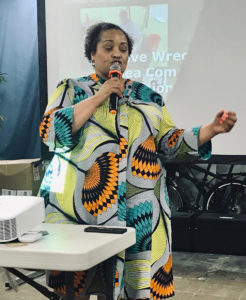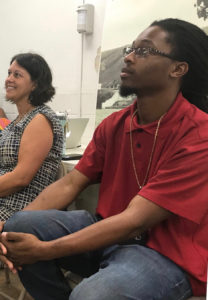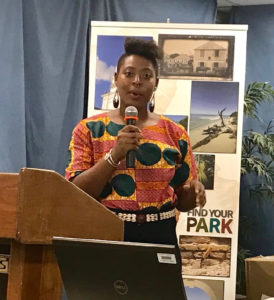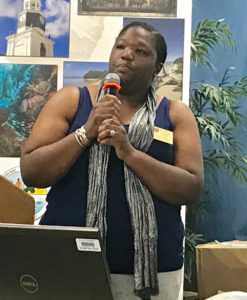
Anchors and other remains of wrecked slave ships off Buck Island and archeological sites filled with artifacts from the daily life of enslaved Virgin Islanders help tell the tale of what life was really like in the territory centuries ago. The National Park Service hosted a talk on the Slave Wrecks Project’s current status and multiple research efforts across St. Croix in a presentation at the Guinea Warehouse in Christiansted.
The highlight of the Thursday evening event was the presence of Mary Elliott, curator of American Slavery at the Smithsonian Institution’s National Museum of African American History and Culture.
She shared some background on the very important work being done on St. Croix in the waters and at the terrestrial sites.
The Slave Wrecks Project partners work in museums and in archives, on coastlines, and in the sea in a dynamic approach to public history that intersects with the latest in science, archaeology, anthropology, and historical research, according to Elliott.
The Slave Wrecks Project is building a global network with local and regional roots and works in a growing list of locations from Mozambique, to South Africa to St. Croix, Senegal, Brazil, and Cuba, she said.
Elliott spoke of the recent sighting of the slave ship Clotilda discovered near Mobile, Alabama.
“People think that no one wants to talk about slavery. You can’t talk about slavery without talking about freedom,” she said.
Since the National Museum of African American History and Culture opened in 2016 in Washington D.C., it has seen seven million visitors. There have been 7,000 daily visitors, including tickets that are sold out months in advance, Elliott noted.
She thanked community members and all of the people who have taken the time to come together to be a part of the undertaking. Elliott gave special recognition to Akeem McIntosh for his work with the National Park Service and the stellar job he did in his 2017 “Who is a Crucian?” project.

Elliott introduced National Park Service archaeologist Meredith Hardy, who told the standing-room-only audience information about the Slave Wrecks Project research efforts that were first launched in 2015 in the U.S. territorial waters and the Western Hemisphere.
The shallow waters at Buck Island were surveyed for two years. During those surveys artifacts found included anchors from the 1830s and 1840s.
According to Hardy, two of the wrecks that carried enslaved people are the English vessels, the Mary (1797) and the General Abercrombie (1803), both now found in the waters off Buck Island. The Mary traveled from Cameroon carrying 266 enslaved people, of whom 244 survived the journey. The General Abercrombie traveled from St. Helena Island with 377 enslaved people, with 339 surviving the journey.

Hardy said the purpose of the Slave Wreck Project is to build local capacity in the field of heritage and cultural resource management and to provide experience in training in heritage resource protection for future generations.
Hardy introduced Justin Dunnavant, of the University of California at Berkeley and Vanderbilt University, to begin the presentation of the work being done by the society at the St. Croix Archaeological Field School.
Dunnavant is a founding member of the Society of Black Archaeologists, who led the St. Croix team of aspiring archaeologists charged with doing a “survey” of the Little Princess Estate, which includes the remains of four cabins of enslaved people, to determine the density of artifacts.
“We invite and encourage people of African descent to enter the field of archaeology to highlight the contributions historically to make what Dr. Hardy is doing standard procedure.”
Dunnavant spoke about community engagement as the hallmark of archaeology.
“It is the foundation of archaeological work going forward with a diverse group of scholars,” he said. “It is an oral history – why get into the field? What sustains them and keeps them in the field? They attend conferences. It’s a two-way street. We highlight promotional opportunities.”
Dunnavant said that African Americans are not often given those opportunities and not often presented with what archaeology has to offer.
“What was life like for enslaved people in the Danish West Indies? How does that compare to enslavement under the British, the French or the Spanish? What makes St. Croix unique and different in many ways? These are some of the critical questions we ask,” Dunnavant said.
“It is very much a mixture of many African communities coming into this space and a mixture of other entities.”

Dunnavant introduced his team members: Ayana Flewellen, UC Berkeley; Alicia Odewale, University of Tulsa; Dr. Alexandra Jones, UC Berkeley and Archaeology in the Community; William White, assistant professor of anthropology at UC Berkeley.
Alicia Odewale gave “good glimpses” of St. Croix history with the Estate Little Princess being purchased by Gov. Frederik Moth in 1749 and 25 acres changing hands in 1834. Gov. Peter von Scholten also owning acreage reveals that both governors technically owned enslaved people over a period of 200 years. The plantation was active into the early 1900s.
Research shows that sugar was the most intensive labor to produce and there was use of the cane trash in the building of the structures. There are the remains of what the people left behind. There were the sugar factories – the great house – the main house shifts to a hospital.
“There is much more of the history to be uncovered,” Odewale said, turning over the microphone to Ayana Flewellen.
Flewellen looked at the domestic Afro Crucians in the late 19th century at the natural, social environment.
“We looked at shared spaces – two small cabins – very small living spaces. There were a couple of excavations between the two structures showing craft producing taking place outside of the home,” she said.
Structures were built of brick and coral and there were upwards of 30 cabins. Those remaining are of coral. In 2018 and 2019 there were large-scale excavations.
The artifacts from Little Princess will travel with Odewale to her laboratory in Tulsa on a temporary loan. “The artifacts belong to the Crucian people – the people who live here,” she said. “We will analyze them looking into the lives of the people who lived and labored here.”
“We are also looking at other types of enslavement at the diaspora of Estate Little Princess and the Christiansted Historic Site and making a comparison. We want to piece together everything we have to tell someone’s story,” Odewale said.
“There is a partnership currently with the University of the Virgin Islands with a memorandum of understanding with the University of Tulsa. The idea is to bring more students to Tulsa for artifact interpretation training and actually partner with Tulsa to help them analyze and research. With this level of training, the eventual research can be done right on St. Croix and the artifacts would not have to leave the island.”
Students will be involved in the new training and digitalization standardized to compare enslavement one to another, Odewale said.
Dunnavant and Flewellen received a $15,000 SWP seed grant to bring students to St. Croix the first year. The two applied for a $200,000 grant, which will enable students from Historically Black Colleges and Universities to fly to UC Santa Cruz to do a session, fly to St. Croix to do the archaeology work and fly them back home.
The students would get a $3,000 stipend for this project.
Flewellen brought seven students from Morgan State University, Spelman College and
Howard University to St. Croix and Haiti to do research.
The students will receive a fee waiver for application to any University of California. Upon entry, they will be funded four to five years of graduate study. The program is available to UVI students to do the work on St. Croix or Haiti. Any graduate program can be afforded to students other than archaeology, anthropology or heritage studies.
Jones is executive director of Archaeology in the Community. She began training 15 students every summer on St. Croix three years ago. Students from the Caribbean Centers for Boys and Girls were trained in actual artifact analysis in the morning. In the afternoon they went out and did the work in the field.
Each year Jones added a different component. Within the past three years, 45 students on St. Croix were trained in archaeology. At the request of executive director Neil Canton, students from the CCB&G will be given a certificate upon completion. A fundraiser to train interns from the previous year will pay them to participate each year.
“I am holding these students under my arm and walking them to college upon completion of high school,” Jones said.
Students will be equipped with field school training and a certificate, which can cost $1,000 to $10,000 and is necessary to get a job in archaeology. All students will have a student membership in the St. Croix Archaeology Society. By the time they hit college, Jones said, they will have consulting as a specialization under their belts.
Jones plans to increase the number of interns to ten students next summer.
Board member of the Friends of NPS Juliet St. Martin thanked the team.
“We’re a very small community. Look at the impact you’ve made. We are so appreciative,” St. Martin said.
NPS Chief of Resource Management Zandy Hillis-Starr closed the lecture by announcing that the NPS is funding the engineering and design to create a Slave Trade Museum at the Guinea Warehouse. Actual funding is going on to do repairs, which might take two to three years. “It will take some time. We are working on it every week to make it happen for us,” she said.






Thanks to Ms McKay for this well written and very thorough reportage on a very important topic. Kudos the the Friends of the VI National Parks for bringing us such great speakers doing this fascinating work and including the young people of the VI in the quest of understanding our past. We all need to focus more on history, lest, as the saying goes, we repeat it.